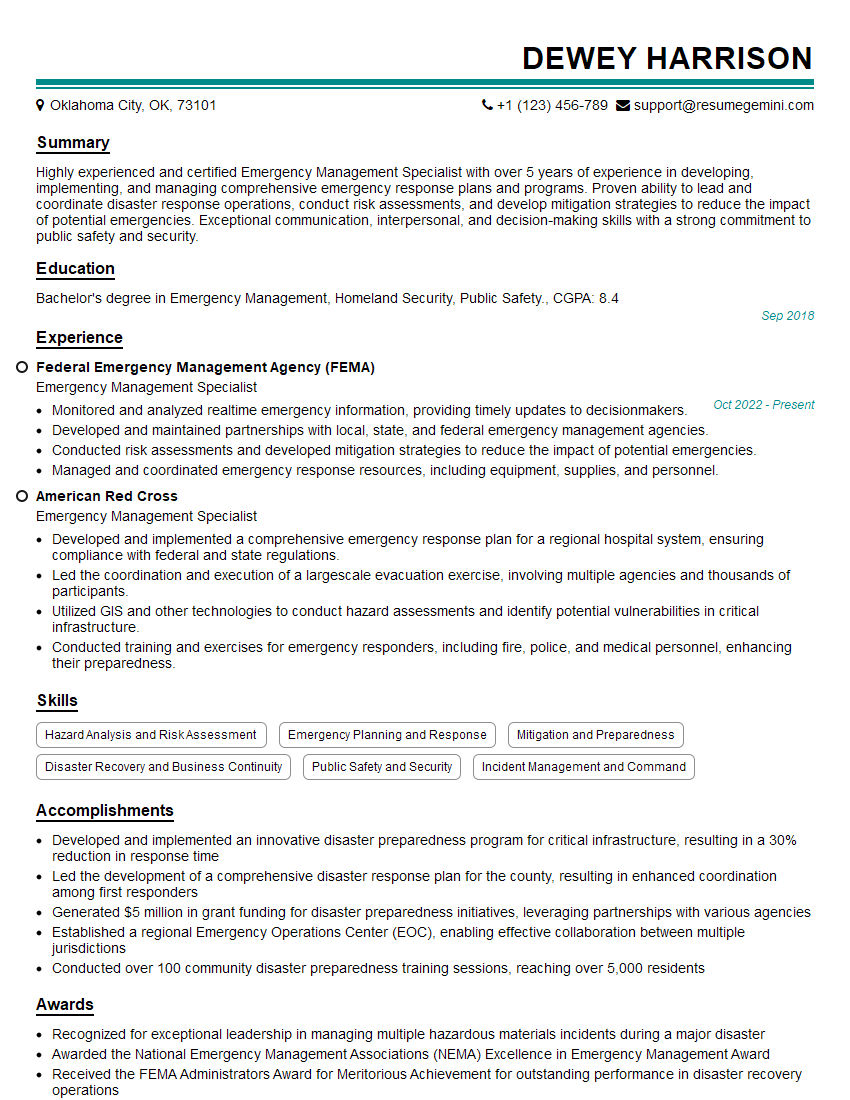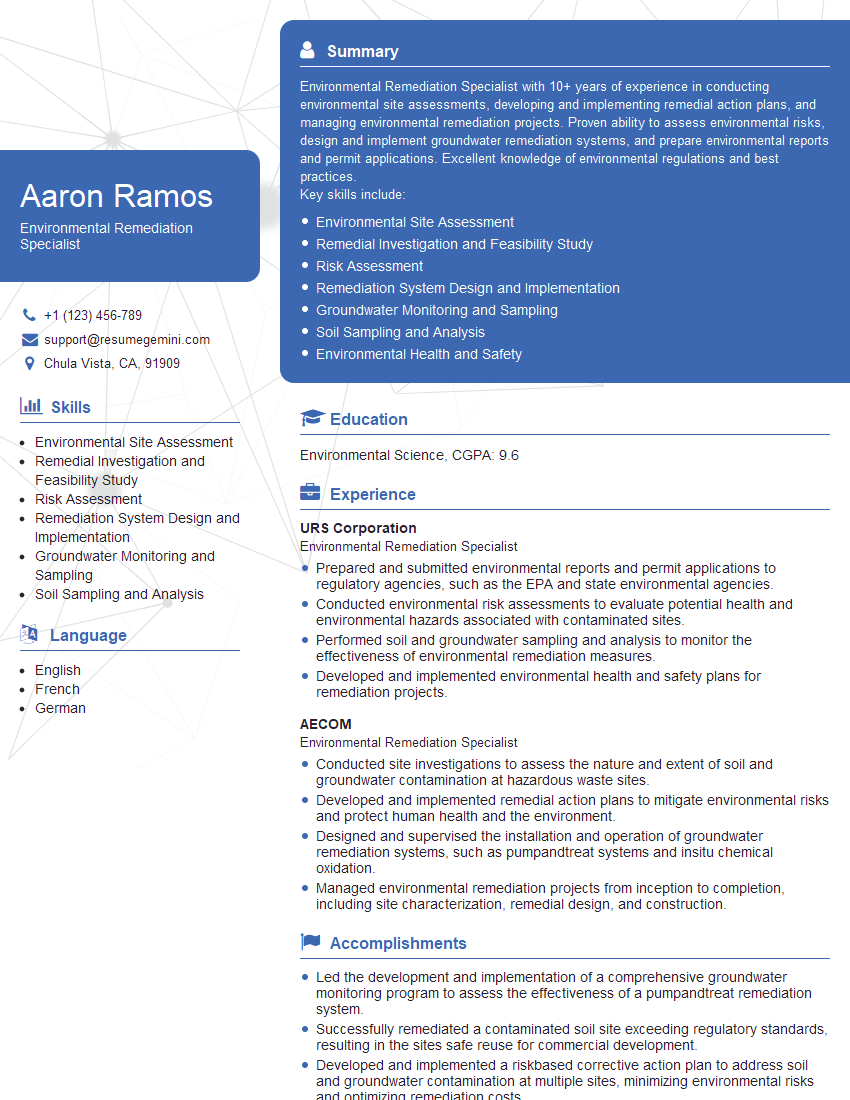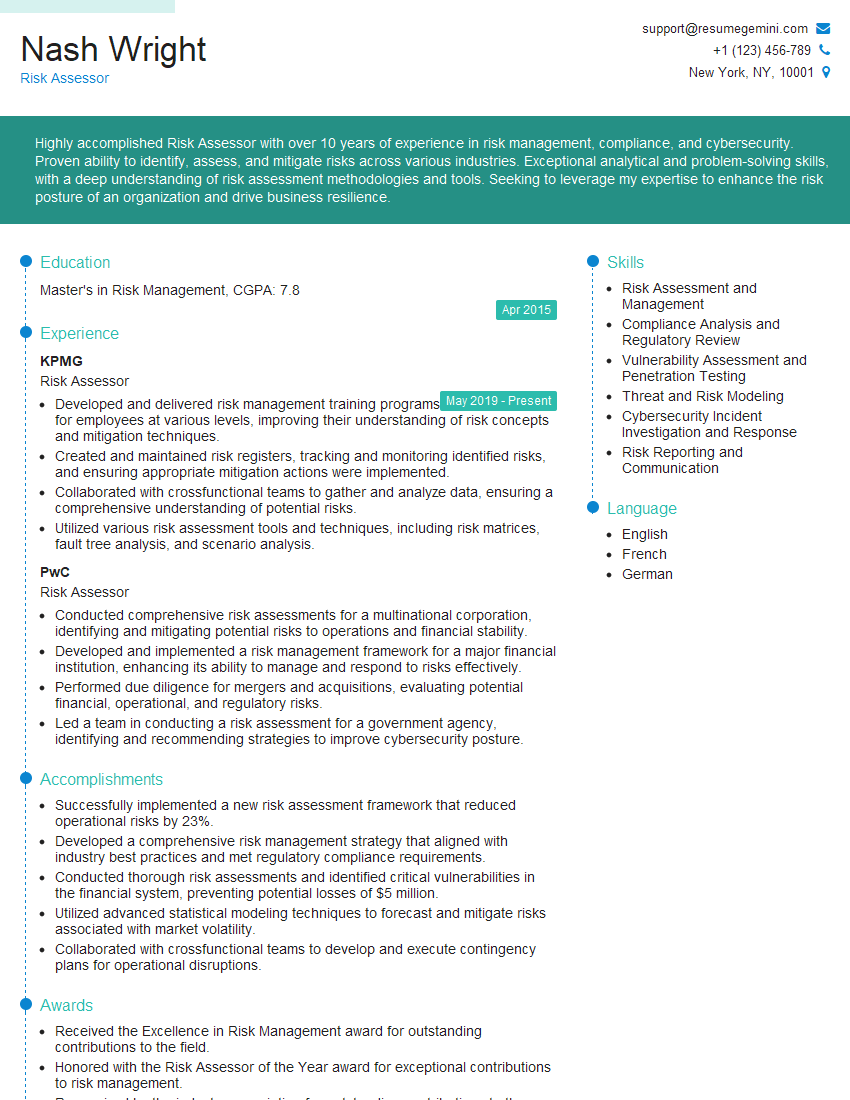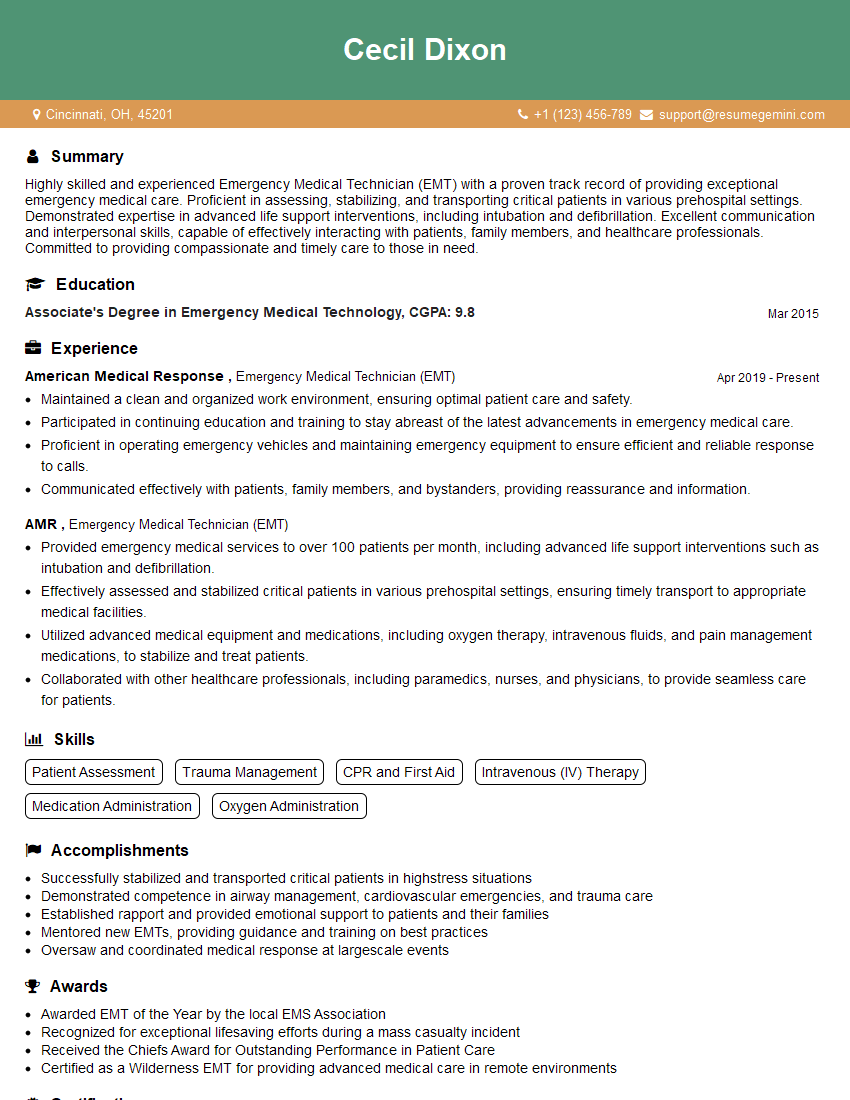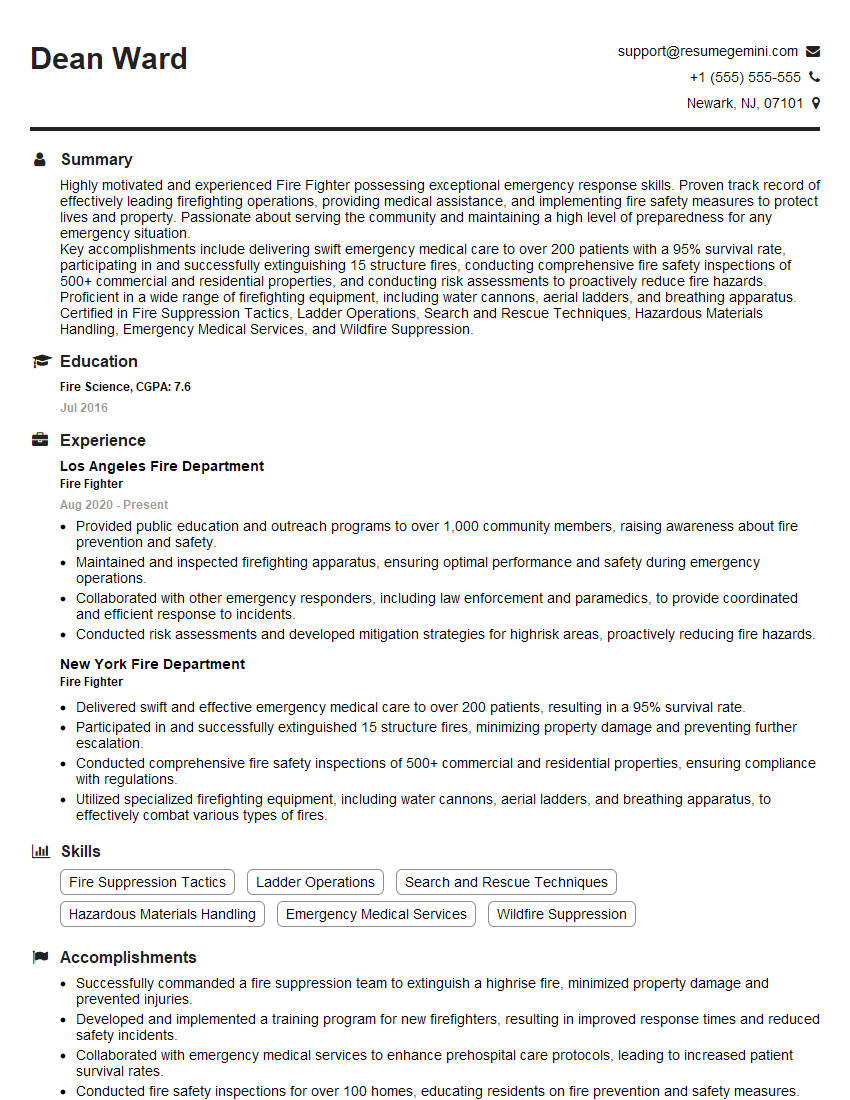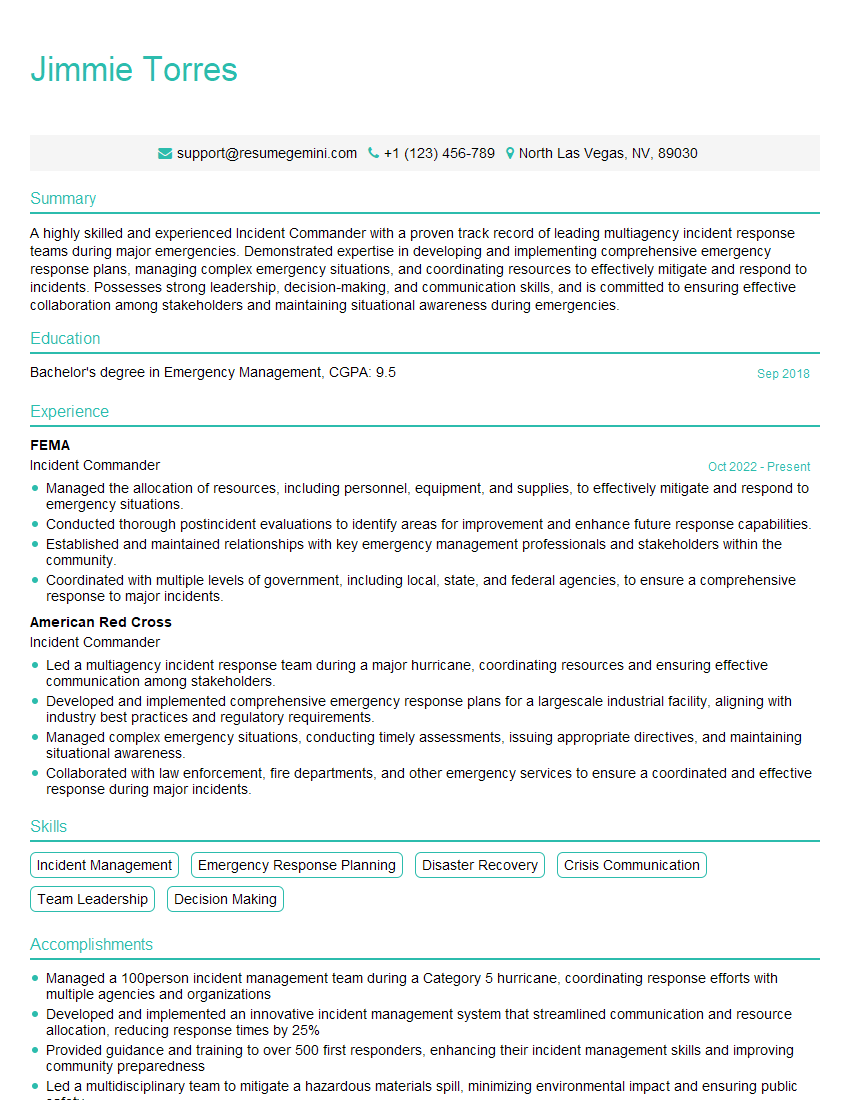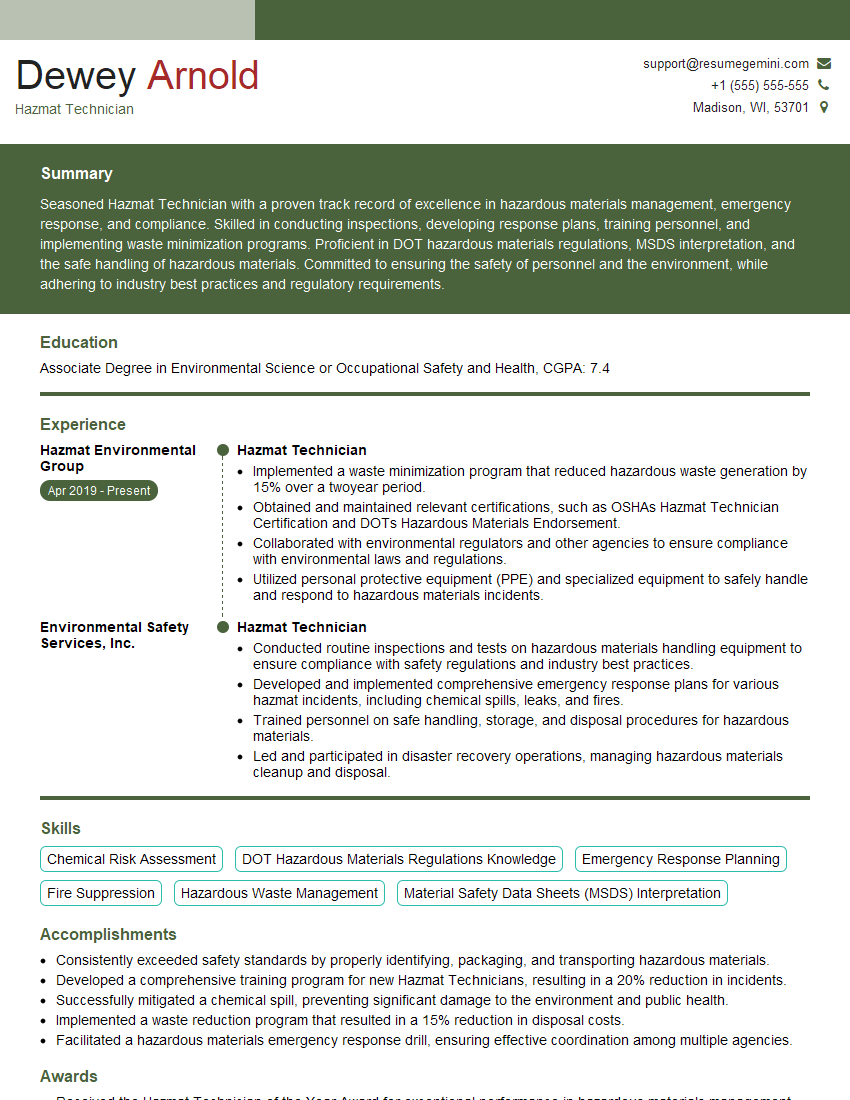Interviews are opportunities to demonstrate your expertise, and this guide is here to help you shine. Explore the essential Emergency Response and Spill Containment interview questions that employers frequently ask, paired with strategies for crafting responses that set you apart from the competition.
Questions Asked in Emergency Response and Spill Containment Interview
Q 1. Describe your experience with developing and implementing emergency response plans.
Developing and implementing emergency response plans is a multifaceted process requiring a deep understanding of potential hazards, regulatory compliance, and effective communication. My experience encompasses leading the creation of plans for various industrial settings, from manufacturing plants handling volatile chemicals to large-scale transportation hubs. This involved conducting thorough risk assessments, identifying potential hazards, and developing detailed procedures for various scenarios. For example, in one project involving a chemical processing facility, I led a team that developed a plan addressing spills, fires, and equipment failures. We used HAZOP (Hazard and Operability) studies to identify potential failure modes and developed specific response procedures for each, including the establishment of clear roles and responsibilities for personnel and the designation of emergency equipment locations. The plans were then rigorously tested through drills and simulations, ensuring all personnel were proficient and the plan was effective.
Implementation included training programs, regular plan updates reflecting changes in operations or regulatory requirements, and post-incident reviews to improve future responses. This proactive approach not only meets compliance requirements but also drastically improves response times and mitigates the impact of potential incidents.
Q 2. Explain your understanding of different types of spill containment methods.
Spill containment methods vary drastically depending on the nature of the spilled material (liquid, solid, gas), its properties (flammability, toxicity, corrosivity), and the environment (land, water). Broadly, methods fall into several categories:
- Containment: This involves preventing the spread of the spill using physical barriers like booms (for water spills), berms (for land spills), or absorbent pads. For example, using absorbent booms to contain an oil spill in a river or using absorbent pads to soak up a chemical spill in a warehouse.
- Diversion: This redirects the flow of the spilled material away from sensitive areas using ditches, dams, or other engineered controls. This is particularly useful in preventing a spill from reaching a waterway or populated area.
- Recovery: This focuses on removing the spilled material. Methods range from simple manual scooping to using specialized equipment like vacuum trucks or skimmers. For example, vacuuming up a solvent spill from a floor or using a skimmer to remove oil from a water surface.
- Neutralization: Certain spills can be neutralized chemically, rendering them less hazardous. This must be done with extreme caution and only with materials specifically designed for the spilled substance. Incorrect neutralization can create even more hazardous byproducts.
- In-situ burning: In some cases, particularly with flammable liquids in remote locations, controlled burning can be a safe and effective method of disposal. This requires stringent safety precautions and environmental considerations.
The selection of the most appropriate method depends on a comprehensive risk assessment, factoring in safety, environmental impact, and cost-effectiveness.
Q 3. How would you assess the risk of a potential spill?
Assessing the risk of a potential spill involves a systematic process incorporating several key elements. It begins with identifying potential sources of spills, such as storage tanks, pipelines, or transportation routes. Next, we analyze the properties of the materials being handled, specifically considering their toxicity, flammability, and reactivity. The likelihood of a spill occurring is then evaluated, considering factors such as the age and condition of equipment, the effectiveness of existing safety measures, and the frequency of past incidents. Finally, we assess the consequences of a spill, which includes the potential environmental impact, the risk to human health, and the potential economic losses.
This comprehensive assessment, often documented using a quantitative risk assessment methodology (like a bow-tie analysis), allows for prioritizing mitigation efforts, allocating resources, and developing effective emergency response plans. For example, a high-consequence, low-probability spill might require a highly specialized response team and extensive emergency equipment, while a low-consequence, high-probability spill might only need basic containment materials and readily available personnel.
Q 4. What are the key components of a successful spill response team?
A successful spill response team is more than just a collection of individuals; it’s a well-trained and coordinated unit operating under a clear command structure. Key components include:
- Trained personnel: Team members need specific training in spill response techniques, hazard recognition, personal protective equipment (PPE) use, and emergency communication procedures. Regular refresher training and drills are crucial.
- Clear roles and responsibilities: Each member should have a defined role, from the incident commander to those handling containment and cleanup. This avoids confusion and ensures efficient response.
- Communication system: Effective communication is paramount. The team must have access to reliable communication tools, ensuring seamless coordination between team members and external agencies.
- Appropriate equipment: The team should have access to the right equipment for various spill scenarios, including containment booms, absorbent materials, protective clothing, and decontamination equipment.
- Emergency response plan: All team members must be familiar with the facility’s emergency response plan, detailing procedures for various scenarios.
- Regular training and drills: Regular practice is crucial for building team cohesion and ensuring that procedures are followed efficiently under pressure.
Think of a well-oiled machine—each part is essential, and its function is well-defined, leading to efficient and coordinated action during a crisis.
Q 5. Describe your experience with hazardous materials (Hazmat) response.
My Hazmat response experience involves extensive training and practical experience in handling various hazardous materials. This includes responding to actual incidents involving chemical spills, gas leaks, and transportation accidents. My certifications include HAZWOPER (Hazardous Waste Operations and Emergency Response) and I’m proficient in identifying, classifying, and handling a wide range of hazardous materials based on their properties, as defined in the Emergency Response Guidebook (ERG).
For example, I was part of a team that responded to a railcar derailment involving the release of anhydrous ammonia. My role involved assessing the immediate threat, establishing safety perimeters, and coordinating the evacuation of nearby residents. We employed specialized equipment and techniques to neutralize and contain the spill, minimizing environmental and health risks. This experience reinforced the critical importance of effective risk assessment, prompt decision-making, and the absolute necessity of following established safety protocols when handling hazardous substances. Documentation, both for regulatory compliance and for future improvement, was also a key aspect of the response and subsequent review.
Q 6. How familiar are you with OSHA regulations related to emergency response and spill containment?
I’m very familiar with OSHA regulations (Occupational Safety and Health Administration) concerning emergency response and spill containment. This includes understanding requirements for hazard communication (HazCom), employee training, emergency action plans (EAPs), personal protective equipment (PPE), and the proper handling of hazardous waste. Specific regulations I’m well-versed in include 29 CFR 1910.120 (Hazardous Waste Operations and Emergency Response), 29 CFR 1910.119 (Process Safety Management of Highly Hazardous Chemicals), and relevant sections concerning emergency planning and response within other OSHA standards.
My familiarity goes beyond simply knowing the regulations; it involves understanding how to apply them practically, ensuring compliance, and building effective safety programs that meet or exceed OSHA requirements. This includes creating and implementing training programs that meet OSHA standards, conducting regular inspections to identify potential hazards, and ensuring that all necessary permits and approvals are in place.
Q 7. Explain the process of containing a chemical spill.
Containing a chemical spill is a time-sensitive process that requires immediate action and a systematic approach. The process typically involves the following steps:
- Assessment: Immediately assess the situation to determine the type and quantity of spilled material, the potential hazards, and the immediate threats. This involves identifying the chemical involved, its properties (flammability, toxicity, etc.), and the extent of the spill.
- Safety and Isolation: Establish a safety perimeter to prevent unauthorized personnel from entering the contaminated area. This may involve evacuating people from the immediate vicinity.
- Containment: Employ appropriate containment methods to prevent the further spread of the spill, such as using absorbent materials, booms, berms, or diverting the flow of the material. The choice of method depends on the nature of the spill and the surrounding environment.
- Recovery: Once the spill is contained, begin the recovery process, which might involve manual removal, vacuuming, or using specialized equipment to remove the spilled material. Proper disposal procedures must be followed.
- Decontamination: Decontaminate the affected area, personnel, and equipment to remove any residual hazardous materials. This might involve washing, using specialized cleaning agents, or other decontamination techniques.
- Disposal: Dispose of the recovered material according to all applicable local, state, and federal regulations. This often includes hazardous waste management protocols.
- Post-Incident Review: Conduct a thorough review of the incident to identify areas for improvement in future emergency responses and prevention measures.
Remember, safety is paramount. Always prioritize the safety of personnel and the environment when responding to a chemical spill.
Q 8. What are the different types of personal protective equipment (PPE) used in spill response?
Personal Protective Equipment (PPE) is crucial in spill response to safeguard responders from hazardous materials. The specific PPE required depends heavily on the nature of the spilled substance. For instance, a chemical spill might necessitate different gear than an oil spill.
- Respiratory Protection: This could range from simple dust masks for less hazardous spills to self-contained breathing apparatus (SCBA) for highly toxic substances. The choice depends on the substance’s toxicity and the concentration in the air.
- Eye Protection: Safety glasses are a minimum; chemical splash goggles or face shields are needed for potentially corrosive or splashing materials.
- Skin Protection: This is paramount. It could involve chemical-resistant gloves (nitrile, neoprene, butyl rubber depending on the chemical), coveralls, and boots. The choice of material depends entirely on the substance’s chemical properties. For example, butyl rubber gloves offer better protection against certain solvents than nitrile.
- Protective Clothing: This might include aprons, coveralls, or even fully encapsulating suits depending on the hazard level. These suits are often made of specialized materials designed to resist specific chemicals.
- Other PPE: Depending on the situation, additional PPE might include hard hats, safety shoes, and hearing protection.
For example, during a chlorine gas leak, responders would absolutely need SCBA, chemical-resistant suits, and eye protection. In contrast, a minor oil spill might only require gloves, boots, and eye protection.
Q 9. How would you handle a situation where a spill impacts a sensitive environmental area?
Responding to a spill in a sensitive environmental area requires a multifaceted, cautious approach. The primary goal is to minimize environmental impact while ensuring responder safety. The exact approach is dictated by the type of spill and the ecosystem.
- Immediate Actions: First, secure the area to prevent further spread. This might involve deploying booms (floating barriers) to contain the spill in water or using absorbent materials on land. Prioritize preventing the spill from reaching especially sensitive areas like wetlands or endangered species habitats.
- Assessment and Identification: Quickly identify the spilled substance to determine its toxicity and environmental impact. Sampling is essential to provide data for effective remediation.
- Containment and Recovery: Employ appropriate techniques to contain and recover the spilled material. This could include vacuum trucks, absorbent pads, or specialized equipment depending on the substance. In sensitive areas, manual cleanup might be preferred to minimize further disturbance.
- Environmental Monitoring: Continuously monitor the area for any further spread or environmental impacts. Soil and water samples should be taken regularly to assess the effectiveness of the cleanup efforts.
- Remediation and Restoration: Once the immediate threat is contained, focus on remediation to restore the environment to its pre-spill condition. This could involve bioremediation (using microorganisms to break down pollutants), soil removal, or revegetation.
- Regulatory Compliance: Follow all applicable local, state, and federal regulations regarding spill response and environmental reporting. Thorough documentation is crucial.
Imagine a spill of pesticides near a salmon spawning stream. Immediate actions would focus on preventing the pesticides from reaching the stream. Then, very careful and targeted recovery would be necessary to prevent harm to the fish population. Environmental monitoring would focus on water quality and fish health.
Q 10. Describe your experience with environmental remediation.
My experience with environmental remediation spans several years and diverse projects. I’ve been involved in the cleanup of various spills, including chemical spills, oil spills, and hazardous waste releases. I’ve worked on both small-scale incidents and large-scale disasters.
One notable project involved the remediation of a contaminated soil site caused by a leaking underground storage tank (UST). This involved soil sampling, risk assessment, excavation of contaminated soil, and disposal in accordance with environmental regulations. We also implemented phytoremediation techniques using plants to absorb and break down contaminants, which reduced the overall remediation time and minimized the environmental footprint.
Another experience involved participating in the cleanup of an oil spill in a coastal area. This required coordinating with multiple agencies and contractors, deploying booms to contain the oil, and using specialized equipment to recover the oil from the water and shoreline. We also conducted extensive environmental monitoring to assess the ecological impacts of the spill.
Throughout my career, I’ve gained hands-on experience with various remediation technologies, including bioremediation, soil washing, thermal desorption, and pump-and-treat systems. I’m proficient in assessing site conditions, developing remediation plans, implementing cleanup actions, and ensuring compliance with environmental regulations.
Q 11. Explain the importance of communication during an emergency response.
Effective communication is the cornerstone of successful emergency response. It’s a crucial factor in coordinating actions, ensuring responder safety, and minimizing environmental and property damage. Clear and concise communication must be established across all levels.
- Internal Communication: This involves clear communication among team members, establishing roles and responsibilities, and maintaining constant updates on the situation’s evolution. A well-defined chain of command is vital.
- External Communication: This encompasses informing the public, regulatory agencies, and other stakeholders about the situation. This includes issuing warnings, providing updates, and disseminating important information through multiple channels (press releases, social media, etc.).
- Technology: Utilizing technology, such as radios, mobile phones, and incident command systems (ICS), facilitates efficient communication across large areas. The use of standardized terminology minimizes confusion.
- Documentation: Meticulous documentation of all communication, actions, and decisions is crucial for post-incident analysis and learning.
Imagine a large-scale chemical spill. Without clear communication, responders could be exposed to unnecessary risks, cleanup efforts could be disorganized, and the public could remain unaware of the danger, potentially leading to severe consequences.
Q 12. How would you manage the resources and personnel during a large-scale spill?
Managing resources and personnel during a large-scale spill requires a structured approach. The Incident Command System (ICS) is a widely adopted framework for organizing and coordinating resources effectively.
- Resource Allocation: Assess the needs based on the spill’s size and nature. This includes equipment (booms, absorbent materials, specialized vehicles), personnel (trained responders, environmental scientists, medical support), and support services (logistics, communication, and transportation).
- Personnel Management: Establish clear roles and responsibilities, assigning tasks to qualified individuals. Regular briefings keep everyone informed and coordinate actions. Safety is paramount, and proper training is essential.
- Logistics: This involves coordinating the supply chain, arranging transportation, and establishing staging areas for equipment and personnel. Efficient logistics minimizes delays and maximizes effectiveness.
- Demobilization: Following the cleanup, a structured process is needed to demobilize personnel and equipment, ensuring all hazardous materials are properly disposed of, and the area is safe.
Think of a major oil tanker spill. ICS helps organize the massive cleanup operation by establishing clear roles for everyone involved: from those containing the spill to those working on environmental remediation. Logistics ensures the timely arrival of specialized equipment and materials from various locations, and communication systems keep everyone informed and coordinated.
Q 13. What are your strategies for preventing future spills?
Preventing future spills involves a proactive, multi-layered approach focusing on engineering controls, procedural improvements, and employee training.
- Regular Inspections and Maintenance: Implement regular inspections of equipment and facilities to identify and address potential leaks or failures before they occur. Proper maintenance is crucial.
- Improved Storage and Handling Practices: Establish and enforce safe storage and handling procedures for hazardous materials. This includes proper labeling, segregation, and secondary containment systems.
- Employee Training: Provide comprehensive training to all employees who handle hazardous materials. This includes awareness of hazards, emergency response procedures, and proper use of PPE.
- Spill Prevention Control and Countermeasures (SPCC) Plans: For facilities that store or handle significant quantities of oil, developing and implementing an SPCC plan is crucial for preventing spills and ensuring rapid response if a spill occurs.
- Emergency Response Plan (ERP): Developing and regularly testing a comprehensive ERP is key to ensuring a coordinated and effective response if a spill does occur.
- Process Safety Management (PSM): Implementing a PSM system can proactively identify and control hazards in processes that handle hazardous materials.
Imagine a refinery. Regular inspections of pipelines and storage tanks, along with employee training on safe handling procedures, significantly reduces the likelihood of a spill. A comprehensive SPCC plan ensures swift response if a leak happens.
Q 14. How would you prioritize actions during a multi-hazard incident?
Prioritizing actions during a multi-hazard incident requires a systematic approach, often employing a tiered system based on the severity and urgency of each hazard.
- Hazard Identification and Assessment: Quickly identify all hazards present, assessing their potential severity and impact on human life, the environment, and property. This may involve using tools like hazard matrices or decision support systems.
- Risk Assessment: Evaluate the likelihood of each hazard occurring and its potential consequences. This will help prioritize actions based on the level of risk.
- Prioritization Matrix: A matrix can be used to visually represent the risks, assisting in prioritizing actions (e.g., a matrix with severity on one axis and likelihood on the other). Hazards with high severity and high likelihood would receive immediate attention.
- Resource Allocation: Allocate resources (personnel, equipment, etc.) based on the prioritized hazards. Focus on mitigating the most significant threats first.
- Communication and Coordination: Ensure effective communication among all responders and stakeholders. A clear chain of command is crucial for coordinating efforts.
Consider a scenario with a wildfire approaching a chemical plant. The immediate priority would be to protect human life from the immediate threat of fire and any potential chemical release. Next, actions would focus on suppressing the fire and preventing the spread of fire to the chemical plant, then address any potential chemical spills.
Q 15. Describe your experience with incident investigation and reporting.
Incident investigation and reporting are crucial for learning from mistakes, preventing future incidents, and ensuring compliance. My experience involves a methodical approach, starting with securing the scene and ensuring responder safety. This is followed by a thorough data collection phase, including witness statements, photographic and video evidence, equipment logs, and environmental monitoring data. I meticulously analyze this data, identifying root causes using tools like fault tree analysis and ‘5 Whys’ to delve into the underlying reasons for the incident. The final step is the creation of a comprehensive report, clearly outlining the incident, contributing factors, corrective actions, and recommendations for preventing recurrence. For example, in one instance involving a chemical spill, my investigation revealed a failure in the safety interlock system, leading to procedural changes and equipment upgrades.
I’ve also developed and delivered presentations to internal and external stakeholders on investigation findings, focusing on actionable insights and safety improvements. My reports adhere to industry best practices and regulatory guidelines, ensuring they’re clear, concise, and legally sound.
Career Expert Tips:
- Ace those interviews! Prepare effectively by reviewing the Top 50 Most Common Interview Questions on ResumeGemini.
- Navigate your job search with confidence! Explore a wide range of Career Tips on ResumeGemini. Learn about common challenges and recommendations to overcome them.
- Craft the perfect resume! Master the Art of Resume Writing with ResumeGemini’s guide. Showcase your unique qualifications and achievements effectively.
- Don’t miss out on holiday savings! Build your dream resume with ResumeGemini’s ATS optimized templates.
Q 16. How familiar are you with various spill response technologies and equipment?
My familiarity with spill response technologies and equipment is extensive. I have hands-on experience with a wide range of tools, from basic absorbent materials like booms and pads to more advanced equipment such as vacuum trucks, specialized pumps, and remote-operated vehicles (ROVs) for underwater operations. I’m also proficient with various containment strategies, including the use of berms, dams, and specialized spill kits tailored to different substances (e.g., oil, chemicals, hazardous materials). My understanding extends to the proper selection and deployment of equipment based on the nature and volume of the spill, environmental conditions, and potential hazards.
For instance, I’ve used specialized sorbents to effectively contain a spill of a volatile organic compound (VOC), preventing its spread into a nearby waterway. In another scenario, I coordinated the deployment of a vacuum truck and a team to remove a large quantity of oil from a highway after a tanker accident.
Q 17. What are the key legal and regulatory requirements for spill reporting?
Legal and regulatory requirements for spill reporting vary depending on the type and quantity of spilled material, location, and potentially involved regulatory bodies (e.g., EPA, state environmental agencies, OSHA). However, some common requirements include immediate notification of relevant authorities (often within a specified timeframe, such as 24 hours), detailed reporting of the type and quantity of spilled substance, the location of the spill, the cause of the spill, actions taken to mitigate the spill, and any environmental impacts. Failure to comply can result in significant fines, legal action, and reputational damage.
The specifics are outlined in regulations like the Clean Water Act (CWA), the Comprehensive Environmental Response, Compensation, and Liability Act (CERCLA), and other relevant state and local ordinances. Understanding these regulations is critical for effective spill response and legal compliance. We often utilize specialized software to help manage reporting and ensure timely submission of all required documentation.
Q 18. How do you ensure compliance with environmental regulations during spill response?
Ensuring compliance with environmental regulations during spill response requires a proactive and multi-faceted approach. It starts with a thorough understanding of applicable regulations and a pre-planned emergency response plan that incorporates compliance measures. This plan should outline procedures for containment, cleanup, waste disposal, and reporting. During the response, we meticulously document all actions, including the quantities of spilled material recovered, the methods used for cleanup, the disposal of contaminated materials, and any environmental monitoring conducted. We collaborate closely with regulatory agencies to keep them informed of progress and to obtain necessary permits or approvals.
For instance, ensuring proper disposal of contaminated soil and water in accordance with hazardous waste regulations is paramount. We utilize licensed disposal facilities and adhere to all reporting requirements to guarantee full regulatory compliance. Regular training for response personnel on environmental regulations and best practices is also critical.
Q 19. Explain your understanding of the different phases of emergency response.
Emergency response typically involves four distinct phases: Preparation, Response, Recovery, and Mitigation. Preparation involves developing and regularly updating emergency response plans, training personnel, procuring and maintaining necessary equipment, and establishing communication protocols. Response is the immediate action taken upon incident detection; it focuses on containing the spill, protecting personnel and the environment, and initiating the notification process. Recovery involves the cleanup and remediation of the affected area, restoring the environment to its pre-incident condition as much as possible. Finally, Mitigation focuses on preventing future incidents through root cause analysis, process improvements, and enhanced training. Each phase is crucial, and a well-executed response requires careful planning and coordination across all stages.
Think of it like fighting a fire: Preparation is like having a fire extinguisher ready, Response is putting out the immediate flames, Recovery is cleaning up the aftermath, and Mitigation is installing smoke detectors to prevent future fires.
Q 20. How would you train employees on emergency response procedures?
Training employees on emergency response procedures is a continuous process that incorporates various methods to ensure competence and retention of key information. This involves a combination of classroom instruction, hands-on training exercises, and regular drills. The training program should be tailored to the specific hazards and potential incidents within the workplace, emphasizing roles and responsibilities, communication protocols, use of personal protective equipment (PPE), and spill response techniques. Regular refresher training and competency assessments are critical for maintaining preparedness. Utilizing scenario-based training and simulations helps employees develop problem-solving skills in realistic emergency situations.
For example, we often use virtual reality (VR) simulations to create immersive training experiences that replicate various spill scenarios, allowing employees to practice their responses in a safe and controlled environment. This improves both theoretical knowledge and practical skills.
Q 21. Describe your experience with emergency response drills and exercises.
I have extensive experience conducting and participating in emergency response drills and exercises, both full-scale and tabletop simulations. These exercises are crucial for testing the effectiveness of emergency response plans, identifying weaknesses, and improving team coordination. I’ve played various roles during drills, from incident commander to team member, gaining a comprehensive understanding of the challenges and complexities involved. Post-exercise evaluations, which I’ve led on numerous occasions, focus on identifying areas for improvement, refining procedures, and updating training materials to ensure continuous enhancement of the overall emergency response capability. We use these exercises to identify bottlenecks in communication, equipment deployment, and personnel response times. This iterative process has significantly enhanced our response capabilities and reduced response time in real-world scenarios.
For example, a recent full-scale drill involving a simulated large-scale chemical spill helped us refine our communication protocols with local emergency services and improve our deployment of containment equipment. The evaluation highlighted some improvements needed in our initial response phase which were addressed promptly.
Q 22. How do you handle stressful situations during an emergency?
Handling stressful situations in emergency response requires a calm, methodical approach. It’s not about eliminating stress, but managing it effectively. My strategy centers around three key elements: preparedness, procedure, and self-care.
- Preparedness: Thorough training and familiarity with emergency response protocols significantly reduce anxiety. Knowing what steps to take minimizes uncertainty during chaotic situations. I regularly review procedures and participate in drills to reinforce my skills.
- Procedure: During an emergency, I focus on executing established protocols step-by-step. This systematic approach prevents panic and ensures consistent, effective action. I delegate tasks efficiently, utilizing the strengths of my team members.
- Self-Care: Recognizing my own limitations is crucial. Stress management techniques, such as deep breathing exercises and regular breaks (when feasible), help maintain focus and prevent burnout. Post-incident debriefings and peer support are also essential for processing the emotional toll of stressful situations.
For example, during a large chemical spill, the initial chaos can be overwhelming. However, by focusing on the established containment and decontamination procedures, assigning tasks to the team, and taking short, controlled breaths, I can maintain composure and guide the team effectively. Post-incident, we hold a debrief to discuss what went well and what could be improved for future responses.
Q 23. Describe a time you had to make a critical decision under pressure during a spill response.
During a significant oil spill at a coastal refinery, we faced a critical decision about deploying booms to contain the spread. The initial assessment indicated a high volume of spilled oil, strong currents, and the potential for environmental damage to a sensitive wetland area. Deploying booms too quickly risked damaging the sensitive ecosystem or being ineffective due to the current, while delaying the deployment risked further environmental damage.
Under immense pressure and with limited time, I utilized a risk assessment matrix. This involved weighing the potential environmental impact against the effectiveness of boom deployment in the existing conditions. We decided to deploy specialized, heavy-duty booms in strategic locations, prioritizing the protection of the wetland while simultaneously attempting to contain the spread within the main channel. We also immediately contacted the Coast Guard for support and aerial surveillance to assess the spread more effectively.
The decision proved crucial. We successfully minimized the oil’s reach into the wetland, preventing a significant ecological disaster. The subsequent cleanup was more manageable, and the damage was ultimately less extensive than initially feared.
Q 24. How do you ensure the safety of your team during an emergency response?
Ensuring team safety is paramount in emergency response. This requires a multi-layered approach that begins before the event and continues throughout the response.
- Pre-Incident Training: Comprehensive safety training covering hazard recognition, personal protective equipment (PPE) use, emergency communication protocols, and incident command system (ICS) procedures is mandatory for all team members. Regular drills and simulations solidify these skills.
- On-Site Safety Protocols: During an emergency, I enforce strict adherence to safety protocols. This includes proper PPE selection and use based on the identified hazards, designated safety zones, and constant communication to monitor team members’ well-being. Each team member has a designated buddy system for improved accountability.
- Hazard Communication and Risk Assessment: Continuous risk assessment and clear communication of the identified hazards are vital. This enables the team to understand potential dangers and adapt their actions accordingly. I ensure everyone is aware of the current situation and their roles within it.
- Post-Incident Debrief: After each incident, we conduct a detailed debrief focusing on lessons learned and identifying areas for improvement in safety protocols and procedures. This ensures continuous enhancement of our safety measures.
For example, during a hazardous materials spill, we immediately establish a perimeter, delineate zones based on hazard levels, and ensure each team member wears appropriate PPE before entering contaminated areas. Constant communication ensures quick response to any safety concerns or emergencies.
Q 25. How do you utilize technology in emergency response and spill containment?
Technology plays a crucial role in modern emergency response and spill containment. It enhances situational awareness, improves communication, and streamlines the overall response process.
- GIS and Mapping Software: Geographic Information Systems (GIS) provide real-time mapping of the spill, allowing for efficient resource allocation and tracking of cleanup efforts. This helps visualize the spread and guides containment strategies.
Example: ArcGIS or QGIS can display spill boundaries and track cleanup crews. - Remote Sensing and Drones: Drones equipped with thermal and multispectral cameras offer a bird’s-eye view of the spill, enabling quicker assessment of its extent and impact. This technology also assists in hard-to-reach areas.
- Data Logging and Monitoring Systems: Real-time data loggers monitor environmental parameters like water temperature, pH, and dissolved oxygen levels. This helps evaluate the extent of environmental damage and track the effectiveness of remediation efforts.
- Communication Systems: Secure, reliable communication systems, including two-way radios and satellite phones, are critical for coordinating response efforts across various teams and agencies.
For instance, during a large pipeline rupture, drones are used to quickly assess the spill’s extent. GIS maps the affected area, enabling efficient deployment of response resources. Data loggers monitor water quality, providing vital information for environmental assessment and cleanup strategies.
Q 26. Explain your experience with different types of monitoring and detection equipment used in spill response.
My experience encompasses a wide array of monitoring and detection equipment used in spill response. The choice of equipment depends largely on the type of spilled material and the environment.
- Gas Detectors: Portable and fixed gas detectors are crucial for identifying and measuring the concentration of volatile organic compounds (VOCs) in the air, ensuring team safety and preventing further exposure.
Example: Photoionization detectors (PIDs) and flame ionization detectors (FIDs) are commonly used. - Oil Spill Detection Equipment: This includes various sensors and remote sensing technologies such as fluorometers, which measure oil fluorescence, and infrared cameras that detect temperature differences associated with oil slicks. Booms and skimmers are used for containment and recovery.
- Water Quality Monitoring Equipment: This involves using probes and sensors to monitor water parameters like pH, dissolved oxygen, turbidity, and temperature. This data helps assess the environmental impact of the spill and guide the remediation process.
- Radiation Detection Equipment: In the event of a radioactive material spill, specialized equipment such as Geiger counters and scintillation detectors are used to measure radiation levels and ensure the safety of personnel and the environment.
For example, during a chemical spill, we used PID detectors to monitor VOC levels, ensuring the safety of our crews. Simultaneously, water quality probes helped assess the impact on a nearby river, providing crucial information for cleanup and environmental mitigation strategies.
Q 27. How do you coordinate with external agencies during a large-scale spill?
Coordinating with external agencies during a large-scale spill is critical for effective response. This involves clear communication, defined roles, and a unified command structure.
- Incident Command System (ICS): Adopting the ICS framework ensures a standardized approach to command, control, and coordination. This provides a clear hierarchy and communication channels.
- Pre-established Contacts: Maintaining a network of contacts with relevant agencies—such as the Coast Guard, Environmental Protection Agency (EPA), local fire departments, and other relevant authorities—is crucial for swift communication and efficient response.
- Joint Information Center (JIC): Establishing a JIC ensures consistent and accurate information dissemination to the public and stakeholders.
- Regular Briefings and Updates: Frequent communication with all involved agencies maintains situational awareness and allows for coordinated decision-making. This typically involves regular briefings and updates through various communication channels.
In a major oil spill scenario, we would establish a unified command with the Coast Guard, working collaboratively to assess the situation, strategize containment, and coordinate cleanup efforts. Regular briefings keep all stakeholders informed about progress and any changes in the response plan.
Q 28. Describe your experience with developing and managing an SPCC Plan.
Developing and managing a Spill Prevention, Control, and Countermeasure (SPCC) Plan is essential for facilities that store regulated amounts of oil. My experience involves the entire lifecycle of SPCC plan development and management.
- Conducting a Facility Assessment: This involves identifying all oil storage areas, potential spill sources, and associated risks. It includes analyzing the facility’s location, environmental sensitivity, and the types and quantities of oil stored.
- Developing the SPCC Plan: Based on the facility assessment, a comprehensive plan is created, detailing preventive measures, spill response procedures, and employee training programs. This aligns with EPA regulations and industry best practices.
- Implementing the Plan: Training employees on the plan’s procedures and conducting regular drills are vital for effective response. This includes proper equipment operation and emergency response protocols.
- Regular Inspections and Maintenance: Routine inspections of storage tanks, piping, and containment systems are necessary to identify potential problems early on. Preventive maintenance ensures equipment functions as intended.
- Updating the Plan: The SPCC plan must be updated regularly to reflect changes in the facility, equipment, or regulatory requirements. This is an iterative process.
I’ve managed numerous SPCC plans, ranging from small industrial facilities to larger refineries. My approach emphasizes rigorous facility assessment, detailed plan development, comprehensive employee training, and continuous improvement through regular inspections and plan updates. This ensures ongoing compliance with regulatory requirements and minimizes the risk of oil spills.
Key Topics to Learn for Emergency Response and Spill Containment Interview
- Incident Command System (ICS): Understanding ICS principles, roles, and responsibilities is crucial for effective team coordination during emergencies. Consider practical applications like managing a simulated spill response using ICS framework.
- Spill Response Planning & Prevention: Learn about developing comprehensive spill prevention control and countermeasures (SPCC) plans, including risk assessment, containment strategies, and emergency procedures. Explore case studies of successful and unsuccessful spill responses to understand best practices.
- Hazardous Materials (HazMat) Identification & Handling: Familiarize yourself with various hazardous materials, their properties, and safe handling procedures. Practice identifying potential hazards in different scenarios and outlining appropriate response strategies.
- Personal Protective Equipment (PPE): Understand the selection and proper use of PPE for different types of spills and hazardous materials. This includes knowing the limitations of various PPE and when to escalate to a higher level of protection.
- Environmental Regulations & Compliance: Be prepared to discuss relevant environmental regulations and reporting requirements following a spill incident. Understand the potential legal and environmental consequences of non-compliance.
- Spill Containment & Remediation Techniques: Learn about various containment methods (booms, dams, sorbents) and remediation techniques (vacuuming, washing, bioremediation). Understand the selection criteria for appropriate techniques based on the type of spill and environmental conditions.
- Emergency Communication & Reporting: Master effective communication protocols during emergencies, including notifying relevant authorities, coordinating with response teams, and providing accurate reports. Practice clear and concise communication under pressure.
- Health & Safety Procedures: Demonstrate a thorough understanding of safety protocols, including emergency procedures, first aid, and worker safety regulations. This includes risk assessments and mitigation strategies.
Next Steps
Mastering Emergency Response and Spill Containment is crucial for career advancement in this high-demand field. It demonstrates a commitment to safety, problem-solving, and environmental responsibility—qualities highly valued by employers. To significantly enhance your job prospects, focus on creating an ATS-friendly resume that highlights your relevant skills and experience. ResumeGemini is a trusted resource that can help you build a professional and impactful resume. We provide examples of resumes tailored to the Emergency Response and Spill Containment field to give you a head start. Take the next step towards your dream career today!
Explore more articles
Users Rating of Our Blogs
Share Your Experience
We value your feedback! Please rate our content and share your thoughts (optional).
What Readers Say About Our Blog
Hi, I represent an SEO company that specialises in getting you AI citations and higher rankings on Google. I’d like to offer you a 100% free SEO audit for your website. Would you be interested?
Dear Sir/Madam,
Do you want to become a vendor/supplier/service provider of Delta Air Lines, Inc.? We are looking for a reliable, innovative and fair partner for 2025/2026 series tender projects, tasks and contracts. Kindly indicate your interest by requesting a pre-qualification questionnaire. With this information, we will analyze whether you meet the minimum requirements to collaborate with us.
Best regards,
Carey Richardson
V.P. – Corporate Audit and Enterprise Risk Management
Delta Air Lines Inc
Group Procurement & Contracts Center
1030 Delta Boulevard,
Atlanta, GA 30354-1989
United States
+1(470) 982-2456

